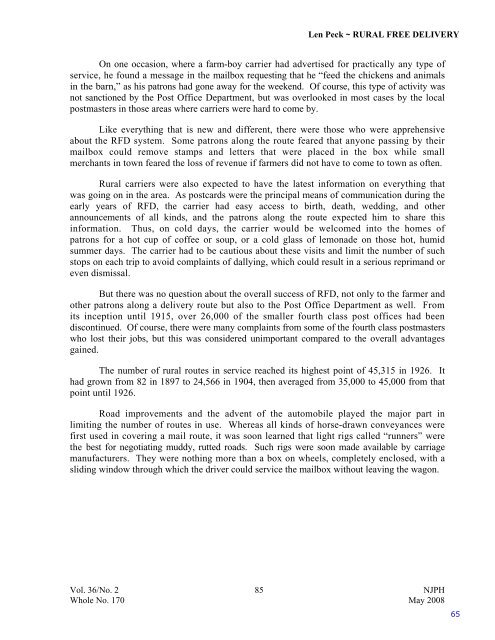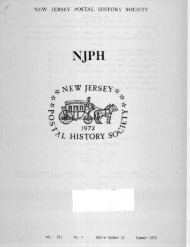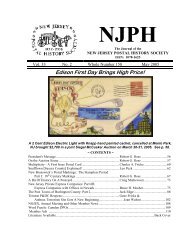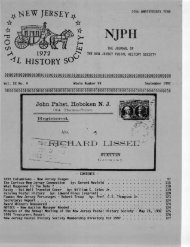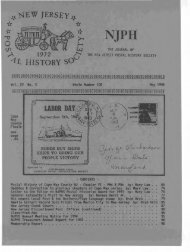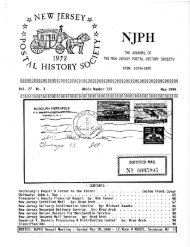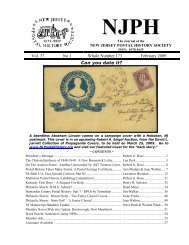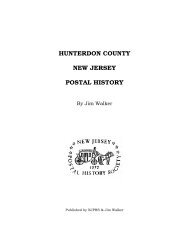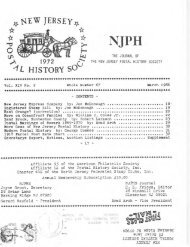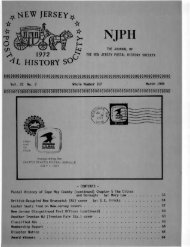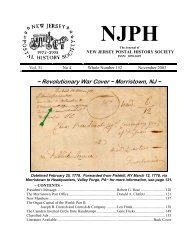Essays on Sussex County and New Jersey Postal History
Essays on Sussex County and New Jersey Postal History
Essays on Sussex County and New Jersey Postal History
Create successful ePaper yourself
Turn your PDF publications into a flip-book with our unique Google optimized e-Paper software.
Len Peck ~ RURAL FREE DELIVERYOn <strong>on</strong>e occasi<strong>on</strong>, where a farm-boy carrier had advertised for practically any type ofservice, he found a message in the mailbox requesting that he “feed the chickens <strong>and</strong> animalsin the barn,” as his patr<strong>on</strong>s had g<strong>on</strong>e away for the weekend. Of course, this type of activity wasnot sancti<strong>on</strong>ed by the Post Office Department, but was overlooked in most cases by the localpostmasters in those areas where carriers were hard to come by.Like everything that is new <strong>and</strong> different, there were those who were apprehensiveabout the RFD system. Some patr<strong>on</strong>s al<strong>on</strong>g the route feared that any<strong>on</strong>e passing by theirmailbox could remove stamps <strong>and</strong> letters that were placed in the box while smallmerchants in town feared the loss of revenue if farmers did not have to come to town as often.Rural carriers were also expected to have the latest informati<strong>on</strong> <strong>on</strong> everything thatwas going <strong>on</strong> in the area. As postcards were the principal means of communicati<strong>on</strong> during theearly years of RFD, the carrier had easy access to birth, death, wedding, <strong>and</strong> otherannouncements of all kinds, <strong>and</strong> the patr<strong>on</strong>s al<strong>on</strong>g the route expected him to share thisinformati<strong>on</strong>. Thus, <strong>on</strong> cold days, the carrier would be welcomed into the homes ofpatr<strong>on</strong>s for a hot cup of coffee or soup, or a cold glass of lem<strong>on</strong>ade <strong>on</strong> those hot, humidsummer days. The carrier had to be cautious about these visits <strong>and</strong> limit the number of suchstops <strong>on</strong> each trip to avoid complaints of dallying, which could result in a serious reprim<strong>and</strong> oreven dismissal.But there was no questi<strong>on</strong> about the overall success of RFD, not <strong>on</strong>ly to the farmer <strong>and</strong>other patr<strong>on</strong>s al<strong>on</strong>g a delivery route but also to the Post Office Department as well. Fromits incepti<strong>on</strong> until 1915, over 26,000 of the smaller fourth class post offices had beendisc<strong>on</strong>tinued. Of course, there were many complaints from some of the fourth class postmasterswho lost their jobs, but this was c<strong>on</strong>sidered unimportant compared to the overall advantagesgained.The number of rural routes in service reached its highest point of 45,315 in 1926. Ithad grown from 82 in 1897 to 24,566 in 1904, then averaged from 35,000 to 45,000 from thatpoint until 1926.Road improvements <strong>and</strong> the advent of the automobile played the major part inlimiting the number of routes in use. Whereas all kinds of horse-drawn c<strong>on</strong>veyances werefirst used in covering a mail route, it was so<strong>on</strong> learned that light rigs called “runners” werethe best for negotiating muddy, rutted roads. Such rigs were so<strong>on</strong> made available by carriagemanufacturers. They were nothing more than a box <strong>on</strong> wheels, completely enclosed, with asliding window through which the driver could service the mailbox without leaving the wag<strong>on</strong>.Vol. 36/No. 285NJPHWhole No. 170 May 200865


